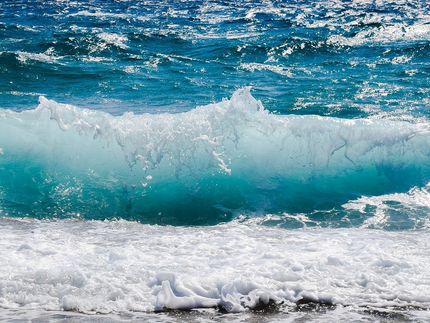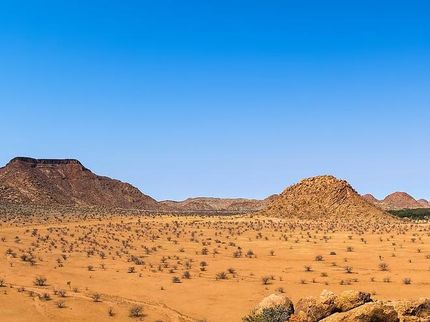Ancient whodunit may be solved: The microbes did it!
Methane-producing microbes may be responsible for the largest mass extinction in Earth's history
Evidence left at the crime scene is abundant and global: Fossil remains show that sometime around 252 million years ago, about 90 percent of all species on Earth were suddenly wiped out — by far the largest of this planet's five known mass extinctions. But pinpointing the culprit has been difficult, and controversial.
Now, a team of MIT researchers may have found enough evidence to convict the guilty parties — but you'll need a microscope to see the killers.
The perpetrators, this new work suggests, were not asteroids, volcanoes, or raging coal fires, all of which have been implicated previously. Rather, they were a form of microbes — specifically, methane-producing archaea called Methanosarcina — that suddenly bloomed explosively in the oceans, spewing prodigious amounts of methane into the atmosphere and dramatically changing the climate and the chemistry of the oceans.
Volcanoes are not entirely off the hook, according to this new scenario; they have simply been demoted to accessories to the crime. The reason for the sudden, explosive growth of the microbes, new evidence shows, may have been their novel ability to use a rich source of organic carbon, aided by a sudden influx of a nutrient required for their growth: the element nickel, emitted by massive volcanism at just that time.
The new solution to this mystery is published this week in the Proceedings of the National Academy of Sciences by MIT professor of geophysics Daniel Rothman, postdoc Gregory Fournier, and five other researchers at MIT and in China.
The researchers' case builds upon three independent sets of evidence. First, geochemical evidence shows an exponential (or even faster) increase of carbon dioxide in the oceans at the time of the so-called end-Permian extinction. Second, genetic evidence shows a change in Methanosarcina at that time, allowing it to become a major producer of methane from an accumulation of carbon dioxide in the water. Finally, sediments show a sudden increase in the amount of nickel deposited at exactly this time.
The carbon deposits show that something caused a significant uptick in the amount of carbon-containing gases — carbon dioxide or methane — produced at the time of the mass extinction. Some researchers have suggested that these gases might have been spewed out by the volcanic eruptions that produced the Siberian traps, a vast formation of volcanic rock produced by the most extensive eruptions in Earth's geological record. But calculations by the MIT team showed that these eruptions were not nearly sufficient to account for the carbon seen in the sediments. Even more significantly, the observed changes in the amount of carbon over time don't fit the volcanic model.
"A rapid initial injection of carbon dioxide from a volcano would be followed by a gradual decrease," Fournier says. "Instead, we see the opposite: a rapid, continuing increase."
"That suggests a microbial expansion," he adds: The growth of microbial populations is among the few phenomena capable of increasing carbon production exponentially, or even faster.
But if living organisms belched out all that methane, what organisms were they, and why did they choose to do so at that time?
That's where genomic analysis can help: It turns out that Methanosarcina had acquired a particularly fast means of making methane, through gene transfer from another microbe — and the team's detailed mapping of the organism's history now shows that this transfer happened at about the time of the end-Permian extinction. (Previous studies had only placed this event sometime in the last 400 million years.) Given the right conditions, this genetic acquisition set the stage for the microbe to undergo a dramatic growth spurt, rapidly consuming a vast reserve of organic carbon in the ocean sediments.
But there is one final piece to the puzzle: Those organisms wouldn't have been able to proliferate so prodigiously if they didn't have enough of the right mineral nutrients to support them. For this particular microbe, the limiting nutrient is nickel — which, new analysis of sediments in China showed, increased dramatically following the Siberian eruptions (which were already known to have produced some of the world's largest deposits of nickel). That provided the fuel for Methanosarcina's explosive growth.
The resulting outburst of methane produced effects similar to those predicted by current models of global climate change: a sudden, extreme rise in temperatures, combined with acidification of the oceans. In the case of the end-Permian extinction, virtually all shell-forming marine organisms were wiped out — consistent with the observation that such shells cannot form in acidic waters.
"A lot of this rests on the carbon isotope analysis," Rothman says, which is exceptionally strong and clear in this part of the geological record. "If it wasn't such an unusual signal, it would be harder to eliminate other possibilities."
While no single line of evidence can prove exactly what happened in this ancient die-off, says Rothman, who is also director of MIT's Lorenz Center, "the cumulative impact of all these things is much more powerful than any one individually." While it doesn't conclusively prove that the microbes did it, it does rule out some alternative theories, and makes a strong and consistent case, he says.




















































